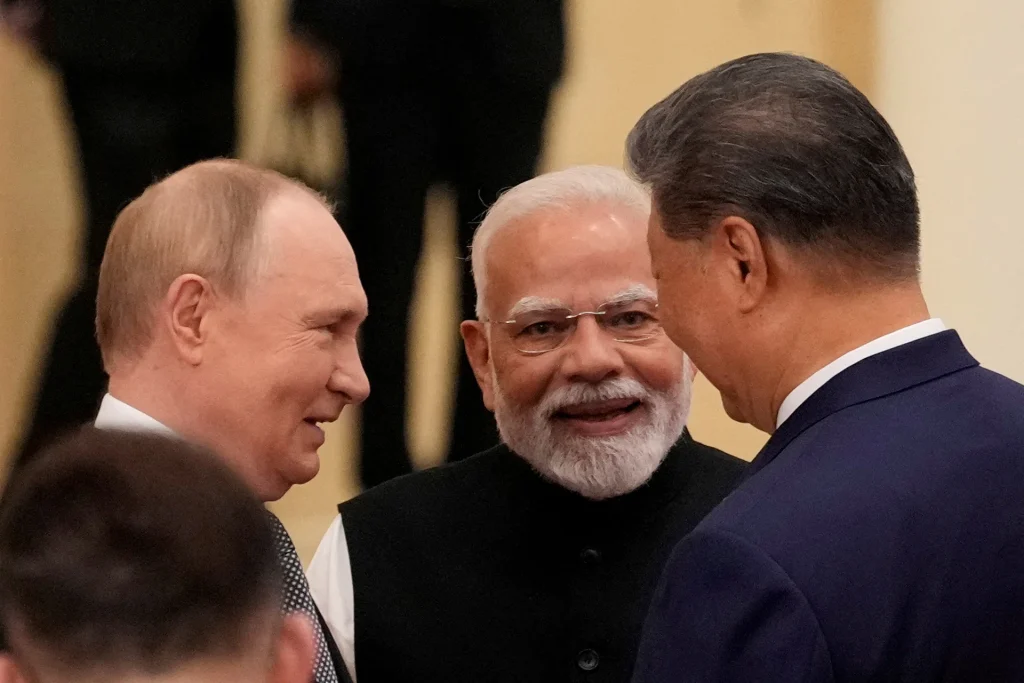THE photograph from the Shanghai Cooperation Organisation (SCO) summit in Tianjin tells a story that should alarm American strategists: Indian Prime Minister Narendra Modi sitting comfortably between Russian President Vladimir Putin and Chinese President Xi Jinping. The three leaders projecting unity in the face of Donald Trump’s renewed presidency.
What we’re witnessing is not merely diplomatic theatre, but the predictable consequence of America’s misguided approach to great power competition – one that prioritises economic coercion over strategic thinking.
Trump’s decision to impose 50 per cent tariffs on India represents a textbook case of what happens when ideological rigidity overrides geopolitical realism.
For over a decade, Washington has invested considerable diplomatic capital in courting New Delhi as a counterweight to China’s rise. The partnership made strategic sense: India’s geographic position, growing economy and democratic institutions offered the US a natural ally in the Indo-Pacific.
Yet with a single stroke of protectionist policy, Trump has pushed Modi into the very embrace America sought to prevent.
In response, Modi has signalled India won’t stop buying oil from Russia, and has moved to patch up ties with Xi, potentially undercutting more than a decade of US efforts to build a partnership with India against China.
BT in your inbox

Start and end each day with the latest news stories and analyses delivered straight to your inbox.
This development should surprise no one familiar with the basic principles of international relations. Nations, like individuals, respond to incentives. When faced with economic punishment from one partner and open arms from another, the choice becomes elementary.
The Trump administration’s faith in tariffs as a diplomatic tool reveals a fundamental misunderstanding of how power operates in the international system.
Economic coercion works best when the target nation has few alternatives and high dependence on the coercing state. India, however, possesses what foreign policy analysts call “strategic autonomy” – the ability to diversify its partnerships and hedge its bets across multiple great powers.
Modi’s meeting with Putin underscored New Delhi’s stance that India prized its old and reliable strategic partners. This is not Indian defiance; it’s Indian realism. New Delhi understands that in a multipolar world, flexibility equals survival.
From Beijing’s perspective, Trump’s tariff war represents an unexpected gift. By alienating India, Washington has handed China an opportunity to fracture the Quad partnership and draw a key regional power back into its sphere of influence.
The optics of the Russian, Chinese and Indian leaders standing shoulder-to-shoulder at the SCO summit, which is seen as a foil to American influence, are devastating for US interests. Visual diplomacy matters, and this image projects an alternative to American leadership.
This episode reflects a broader failure in American strategic thinking: the tendency to treat economic relationships as zero-sum competitions rather than positive-sum arrangements that can reinforce security partnerships. The same mindset that views trade deficits as national humiliation also sees every dollar of Indian-Russian energy trade as a blow to US’ prestige.
Such thinking ignores the complex realities of international commerce and energy security. India’s continued purchases of Russian oil reflect not geopolitical alignment but economic necessity. New Delhi lacks the luxury of virtue signalling when it comes to energy imports; it must prioritise the practical needs of its 1.4 billion citizens over Washington’s preferences.
A realist alternative
A more sophisticated approach would recognise that India’s ties with Russia and China need not preclude deeper partnership with the US.
Strategic triangulation – maintaining beneficial relationships with multiple great powers – represents rational statecraft, not betrayal. Washington’s goal should be to ensure that the US remains India’s most attractive long-term partner, not to force New Delhi into an artificial binary choice.
This requires abandoning the illusion that economic punishment can reshape the strategic calculations of major powers. Instead of tariffs and ultimatums, American diplomacy should emphasise positive inducements: technology transfer, infrastructure investment, and security cooperation that serves mutual interests.
The damage from Trump’s tariff diplomacy may already be done, but it is not irreversible. The sight of Modi, Xi, and Putin standing together should serve as a wake-up call: When America acts like an imperial hegemon rather than a strategic partner, it pushes natural allies towards its competitors.
The photograph from Tianjin is a preview of a US-free Asian order that could emerge if Washington continues to mistake coercion for strategy. Will American leaders learn from this self-inflicted wound or double down on the policies that created it?


